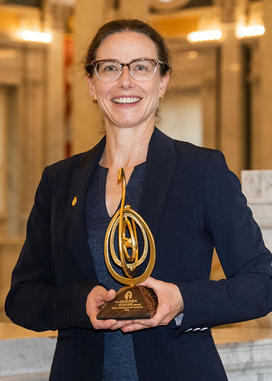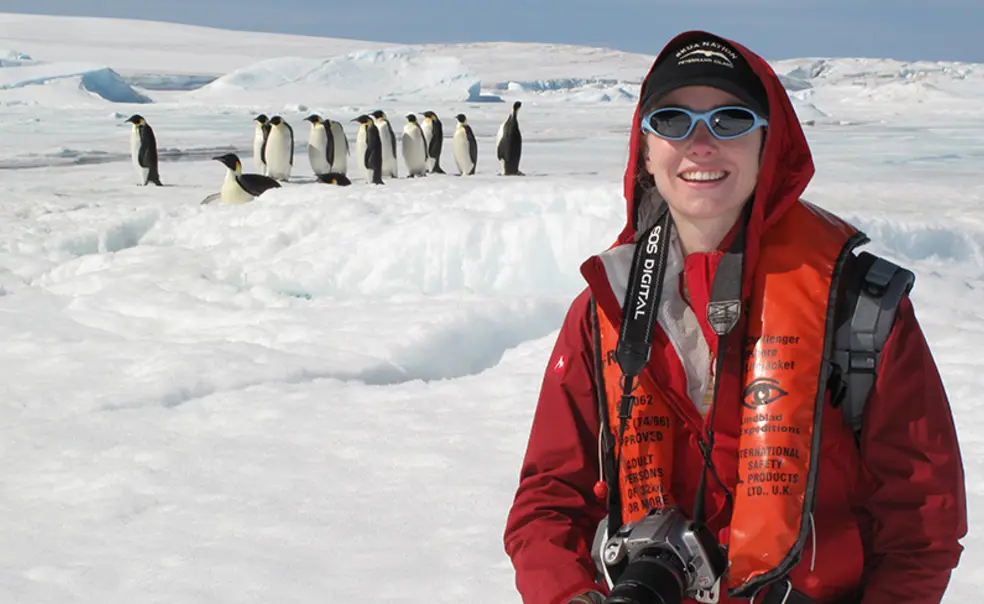Heather Lynch ’00 Uses Satellites to Study Penguins and Climate Change
‘It’s kind of cracked open this whole field of people who are starting to look at wildlife remotely’
A lecture changed the direction of Heather Lynch ’00’s career.
After she “fell in love” with physics as an undergraduate, Lynch was pursuing a Ph.D. when she attended one of Al Gore’s PowerPoint presentations that would later form the 2006 documentary An Inconvenient Truth, which highlighted the dangers of climate change and the need for immediate action.
“I walked out of that lecture really feeling sort of called to action,” Lynch says, noting that she also attended other lectures at the time “that really made me feel like there were environmental problems that I should be working on.” So halfway through her Ph.D. program in physics, she switched to the organismic and evolutionary biology department.
Lynch’s research pivoted to working with “found data sets,” or data that was collected for a long time for another reason but can be analyzed for a new purpose, even if it’s often missing information. In other words: “I tend to work on data sets that only a mother could love and try to do the best I can with them,” she says. When she graduated, Lynch wanted to work with a particular researcher from the University of Maryland who had just started working with this kind of data on penguin populations in Antarctica.
“While it would be easy to assume — and most people do — that what attracted me to that job was the opportunity to work in Antarctica, it really was actually this data,” Lynch says. “I don’t want to say it was a mess, but it needed a little tender loving care, and it took me four years of work to get it into the position where we could start analyzing how populations have really changed over time.”
Lynch conducted field work that required sleeping in tents or on commercial cruise ships in Antarctica, but there are just so many penguin colonies — almost 900 across the continent, and many of them are hard to get to — that her team needed to find another way to make their count. So Lynch and her colleagues turned to satellite imagery to track penguins in a surprising way: “It turns out that you can see penguin guano — like, penguin excrement — from space.”
The bright pink-red guano contrasts easily with the white expanse of Antarctica’s landscape, and since penguins pack so densely in colonies, and the colonies are so large, Lynch has been able to use satellite imagery and computer automation to routinely monitor penguins’ population growth and movement across Antarctica. “Because the Antarctic Peninsula is warming so quickly, we’re seeing changes from one year to the next,” Lynch says, noting that her team developed a website, penguinmap.com, which contains all census data that has been collected on Antarctic penguins since 1979.

This fall, Lynch’s work was recognized by the American Association for the Advancement of Science with the coveted Golden Goose award, which recognizes federally funded research that may seem obscure but has led to major breakthroughs and societal impact. The impact of her work is clear: Satellite technology is now also being used to track Antarctic seals and whales, as well as other large-bodied mammals like elephants, walruses, and polar bears around the world.
“Satellites are kind of giving us this window into Antarctic ecology that we just didn’t have before,” Lynch says. “It’s kind of cracked open this whole field of people who are starting to look at wildlife remotely.”
Now, after a lecture changed the course of her life, Lynch is giving lectures of her own as the host of a National Geographic Live stage show, “Penguins of Antarctica.”
“That was, like, the most exciting opportunity ever to land on my desk,” Lynch says. “The level of sophistication in the audience is just so high and people have such great ideas and questions and concerns about the Antarctic, so I think I’ve learned as much as they have.”
One of the goals of the show is to give people a perspective of what it’s like to be in Antarctica, and Lynch has a special surprise for the audience at her upcoming shows: Using her collection of penguin guano, she worked with a scent lab and a chemist to create a scratch and sniff sticker. ‘It’s like world’s worst perfume, but they can see what a penguin colony smells like,” Lynch says. “It’s something they won’t easily forget.”












No responses yet